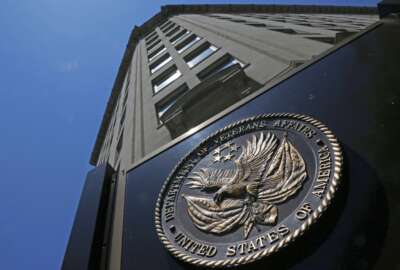

The Department of Veterans Affairs sees progress on its hiring goals, as well as decreased attrition, as positive signs that it will be able to retain the healt...
The Department of Veterans Affairs sees progress on its hiring goals, as well as decreased attrition, as positive signs that it will be able to retain the health care workforce it needs to handle a surge of new patients.
Undersecretary for Health Shereef Elnahal told reporters Tuesday the Veterans Health Administration hired more than 18,500 new employees so far in fiscal 2023.
That brings the VHA’s total workforce to about 388,000 employees. That’s compared to a workforce of 380,000 employees at the start of the fiscal year.
VHA, to date, has seen a 2.1% increase in total employees brought on board, and expects to exceed its goal of a 3% increase in staffing by the end of fiscal 2023.
“We are on pace to not only meet that goal, but exceed it for the fiscal year,” Elnahal said.
The VHA still plans to hire 52,000 employees by the end of fiscal 2023 to meet its workforce goals. But a lower attrition rate, meaning fewer VHA employees are retiring or otherwise leaving the agency, means the agency may not necessarily need to hire so aggressively in the coming months.
“If we keep up our retention, as we have in the first four months [of FY 2023], then we may not even have to hire that many people,” Elnahal said. “We’re tracking the gold standard here, which is the number of employees on board to serve veterans.”
Elnahal said VHA is especially seeing better retention in “key” positions, including nurses.
“Embedded within our priority to hire better and faster is also an equally important priority around retention,” Elnahal said.
Elnahal attributed a lower attrition rate to a workplace culture that has improved with a focus on “more respect and inclusiveness of the front-line [employees] and deference to expertise.”
“This is a process that takes several years. For organizations that have been on this journey for longer than VA, they will tell you the same thing. And I think we’re finally starting to see the fruits of it, when it comes to employee retention,” Elnahal said.
As part of its hiring goals, VHA is specifically looking to hire 30,000 employees in its “big seven occupations” that make up most of its front-line workforce. Those positions include physicians, nurses, housekeeping aides, medical support assistants, nursing assistants, licensed practical nurses and food service workers.
“They keep our clinics and hospitals moving on behalf of veterans, and so there’s a particular key focus on jobs that have been more difficult to retain and are extremely critical to the mission,” Elnahal said.
To stay on top of VHA workforce targets, Elnahal said VHA will plan to “proactively” hire for about 35% of its positions, up from 25%.
“In other words, keep a constant churn of open positions and keep advertisements happening for new hires going constantly across the system,” he said.
Elnahal is also directing the human resources teams at each Veterans Integrated Services Network (VISN) to reduce the time-to-hire by 10% through process improvement and addressing “unique bottlenecks” across the country.
VHA is also looking to staff up its HR offices across the country. Elnahal said it’s making some progress on that effort through its HR Star Program, a one-year apprenticeship program that retrains current VA employees to become human resources specialists.
“It’s not only bringing more people on, it’s bringing trained people on to our unique authorities. And that will hopefully help increase throughput across hiring more generally,” Elnahal said.
The VA under the Trump administration launched an HR modernization initiative to centralize the HR functions of individual hospitals into their regional Veterans Integrated Services Networks.
But Elnahal said this centralization effort brought together a set of employees that had never worked as a team before. It also brought HR specialists into each step of the hiring and onboarding process, which created new “handoffs” with each new hire.
“Whenever you introduce handoffs into any process, there’s a chance that that process will not be fulfilled in a timely way, or in a reliable way. And so, we’re seeing that phenomenon already,” Elnahal said.
VA Secretary Denis McDonough said last September that HR modernization efforts under the Trump administration have “underperformed in the last several years,” and been a “source of considerable agitation for our VA medical centers.”
McDonough more recently said the VA’s time-to-hire, in some cases, is around 90-100 days.
Meanwhile, Elnahal said the VHA is “moving as fast as [they] can” to implement all of the new hiring authorities outlined in the PACT Act. The VA finalized all the workforce regulations linked to the PACT Act at the end of the calendar year 2022.
“Of the authorities that we were given, we now have published policy and are executing on all of those,” Elnahal said.
The PACT Act removed restrictions on how many housekeeping aides VHA could hire, and expedited hiring of college graduates and post-secondary students.
Elnahal said the VHA is also acting now on higher limits for student loan repayments, recruitment, relocation and retention incentives and special contribution awards, and eliminating the statutory limits on awards and bonuses.
The PACT Act is expected to bring an additional 3.5 million veterans into VA benefits and health care. The VA, to date, has conducted initial screenings of veterans for toxic exposure. About 40% of veterans screened suspect they have been exposed to a toxin sometime during their service.
While VHA has gained new authorities to hire under the PACT Act, Elnahal said the agency also has the authorities needed to fire alleged poor performers and those accused of misconduct.
Several top Republicans on the House VA Committee asked McDonough to challenge a ruling from the Merit Systems Protection Board, which in a decision last month, ruled that an entire category of medical personnel aren’t subject to the VA’s fast-track removal process under the 2017 VA Accountability Act and Whistleblower Protection Act.
MSPB, in its Jan. 4 ruling, decided the VA can’t use the 2017 law to expedite the firing of “hybrid” Title 38 employees.
“We do not feel that, especially after multiple courts have made decisions about our latitude in using such an authority against broader federal law, that we really need that authority going forward to hold employees accountable … I’m not concerned about the use of that section in terms of our ability to hold employees accountable,” Elnahal said.
VHA is also looking to address issues with the troubled rollout of its new Electronic Health Record.
Elnahal said the VA is working on a new set of “readiness criteria” that will help the department decide whether it’s able to proceed with resumed go-lives of the EHR.
Elnahal said VA medical centers currently using the Oracle-Cerner EHR are relying on workarounds for some processes that “do not allow them to be as efficient at the point of care as they would like to be.”
“One of my bigger concerns, especially when it comes to the sustainability of the system, is allowing for a configured system that at least gets us to pre-deployment productivity,” he said.
The VA’s upcoming readiness criteria will especially be valuable to determine whether the EHR is ready to launch at larger, more complex VA medical centers.
The VA recently postponed the EHR launch at its medical center in Ann Arbor, Michigan. The EHR is now scheduled to go-live in late 2023 or early 2024. The EHR was previously scheduled to go live in July.
Elnahal said the Ann Arbor delay is related “directly to functionality within Cerner around clinical research,” and that the facility is one of many VA medical centers that partner with academic institutions on veteran clinical trials.
Elnahal said VA delayed the Ann Arbor go-live to not put the facility’s research grants at risk.
“We don’t want to do that, run the risk of that in our organization, because we want our faculty to remain at VA, and to be able to pursue not only clinical care, but a major part of their careers, which is research. But we are working with Oracle-Cerner to be able to make that right, so that facilities like Ann Arbor, not just in Ann Arbor itself, will be able to deploy this system safely and effectively,” he said.
Elnahal said the VA is close to having a revised execution plan for upcoming EHR go-lives.
“We’re basically on the cusp of having that execution plan. And many of these issues are already being addressed. We will then take that evidence-based input and determine what a real deployment schedule should look like,” he said.
Copyright © 2024 Federal News Network. All rights reserved. This website is not intended for users located within the European Economic Area.
Jory Heckman is a reporter at Federal News Network covering U.S. Postal Service, IRS, big data and technology issues.
Follow @jheckmanWFED


 First Look
First Look 